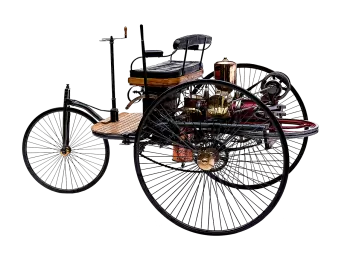
A first example of the history of the known from rotary to alternative movement is the crank mechanism. The oldest manual cranks appeared in China during the Han Dynasty (202 BC-220 AD). Several sawmills in Roman Asia and Byzantine Syria during the III-VI centuries AD had a connecting rod mechanism that converted the rotary motion of a water wheel into the linear movement of the saw blades. In 1206, the Arab engineer Al-Jazari invented a crankshaft.
Piston motor
A free piston engine is a linear internal combustion engine, in which the movement of the piston is not controlled by a crankshaft, but by the interaction of the gas forces of the combustion chamber, a bounce device and a charging device.
The purpose of all these piston engines of history is to generate energy. In the free piston engine, this power is not supplied to a crankshaft, but is extracted through the pressure of the exhaust gas that drives a turbine, by a linear load such as an air compressor for pneumatic power or by incorporating an alternator linear directly on the pistons to produce electric power.
The history of the piston engine was developed in Europe during the 18th century, first as an atmospheric engine and later as a steam engine. These were followed by the Stirling engine and the internal combustion engine in the 19th century. Nowadays, the most common form of alternative engine is the internal combustion engine that works with the combustion of gasoline, diesel, liquefied petroleum gas (LPG) or compressed natural gas (CNG) and is used to power motor vehicles and engine plants.
First generation piston engine
The modern free piston engine was proposed by RP Pescara and the original application was a single piston air compressor. Pescara established the Pescara Technical Office to develop free piston engines and Robert Huber was the technical director of the Office from 1924 to 1962.
The motor concept was a subject of great interest in the 1930-1960 period, and several commercially available units were developed. These first generation free piston engines were, without exception, opposed piston engines, in which the two pistons mechanically joined to ensure symmetrical movement. Free-piston engines provided some advantages over conventional technology, including compactness and a vibration-free design.
Alternative engines featured throughout the history of the reciprocating engine
Within the history of the reciprocating engine, a notable alternative engine of World War II was the radial engine Pratt & Whitney R-4360 "Wasp Major" of 28 cylinders and 3,500 hp (2,600 kW). He drove the last generation of large piston engine aircraft before jet engines and turboprops took power from 1944 onwards. It had a total engine capacity of 71.5 L (4,360 cubic feet), and a high power-to-weight ratio.
The largest reciprocal engine in production today, but not the largest ever built, is the Wärtsilä-Sulzer turbocharged diesel engine RTA96-C built by Wärtsilä in 2006. It is used to feed the larger modern container ships, such as the Emma Mærsk. It is five stories high (13.5 m or 44 feet), 27 m (89 feet) long and weighs more than 2,300 metric tons (2,500 short tons) in its larger version of 14 cylinders that produces more than 84.42 MW (114,800 bhp) . Each cylinder has a capacity of 1,820 L (64 cubic feet), which makes a total capacity of 25,480 L (900 cubic feet) for the larger versions.



